Abstract
Establishment of infection with Helicobacter pylori and gastritis in nonhuman species is currently only successful in gnotobiotic piglets. This study was designed to determine whether H. pylori will colonize the gastrointestinal tract of gnotobiotic dogs. Gnotobiotic beagle pups were derived by standard methods. Group A (five dogs) was orally challenged with 3 x 10(8) H. pylori at 7 days of age. Group B (two dogs) received only peptone water but was contact-exposed beginning on day 23 postinfection (p.i.). Necropsy was performed on dogs on day 30 p.i. H. pylori colonized the stomach of all dogs (groups A and B). Urease map analysis correlated with the microbiologic findings and indicated that the density of colonization was less than that observed in human tissue. Organisms were also recovered from the pharynx, esophagus, duodenum, and rectum of 1, 2, 2, and 1 dog, respectively. All group A and one group B dog developed serum immunoglobulin G specific for H. pylori by day 30 p.i. Gross lesions were restricted to the stomach and consisted of small (less than 1 mm) lymphoid follicles. Microscopically, there were focal to diffuse lymphoplasmacytic infiltrates with follicle formation and mild to moderate infiltration of neutrophils and eosinophils in the gastric lamina propria. With the Warthin-Starry silver stain, organisms were seen on the surface of the gastric epithelial cells, beneath the mucus layer. We conclude that H. pylori colonizes the stomachs of gnotobiotic dogs for at least 1 month and the lesions resemble those seen in humans. H. pylori is transmissible by contact from infected to noninfected dogs.
Full text
PDF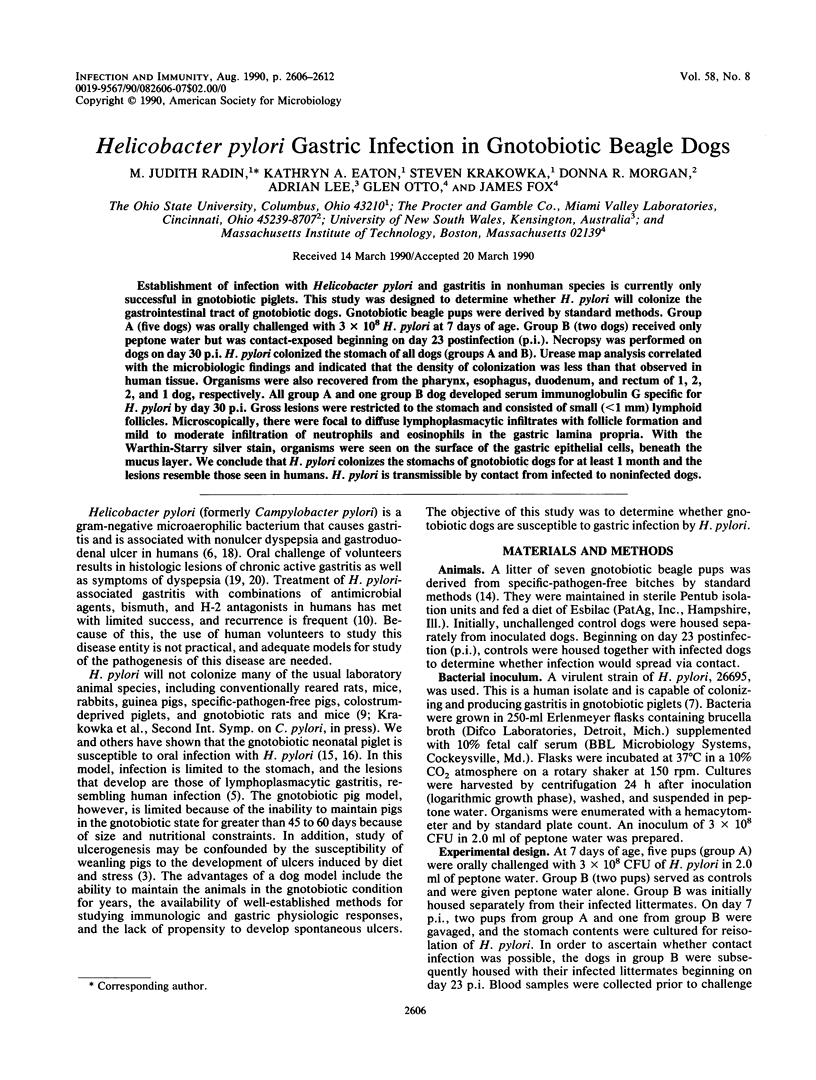
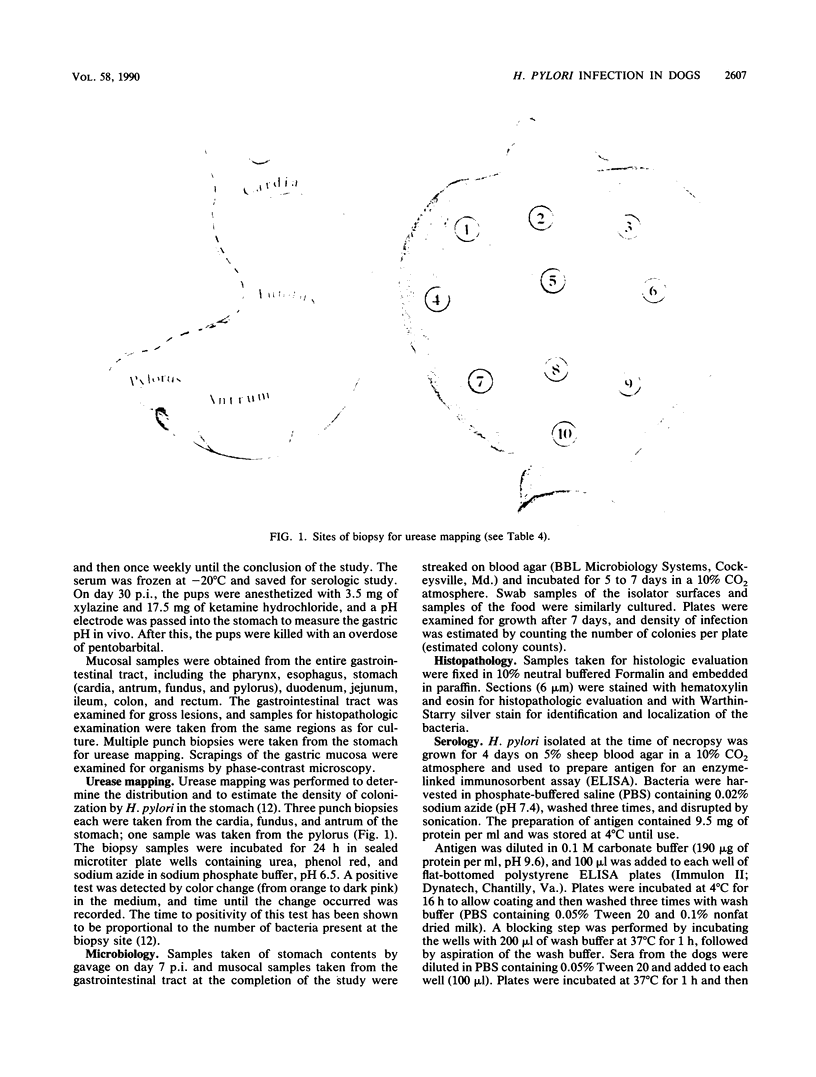
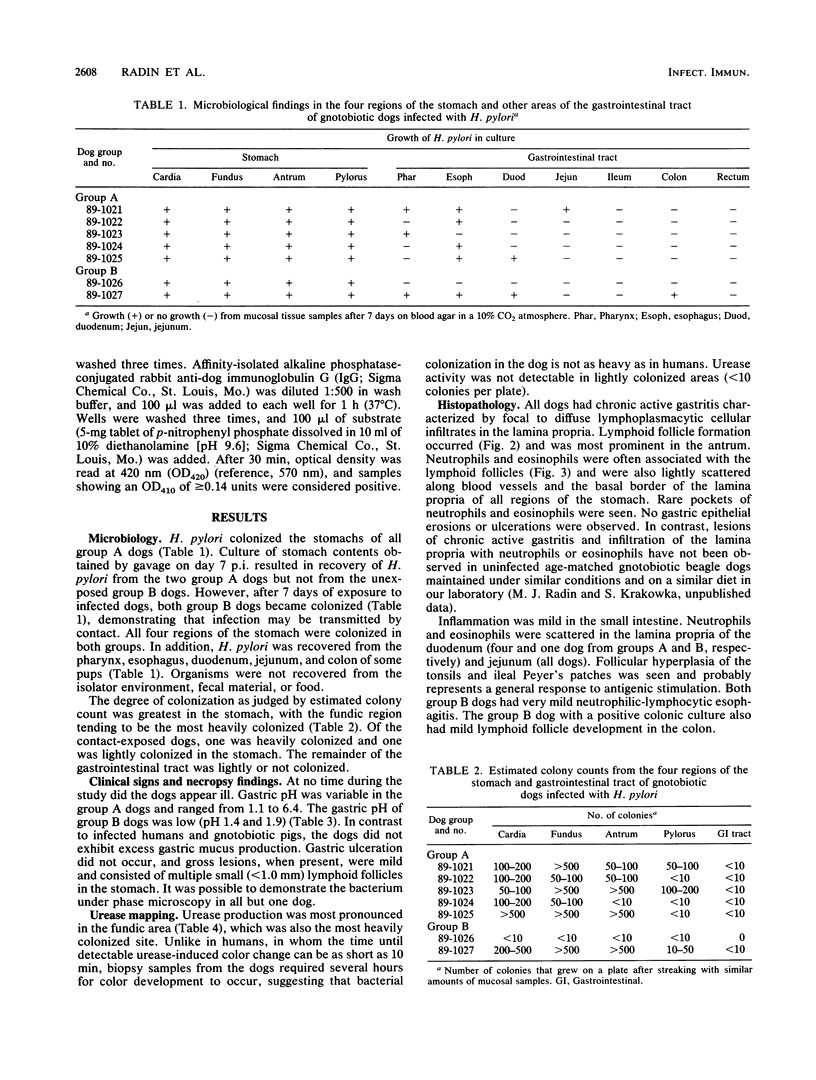
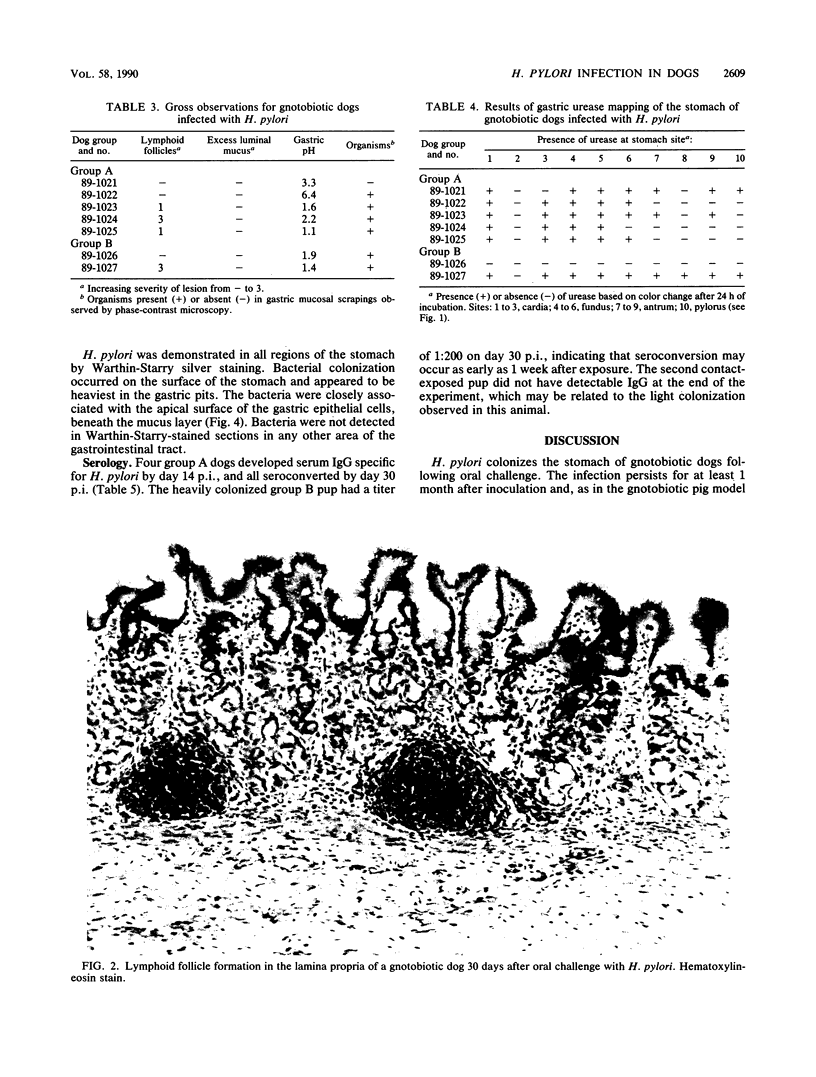
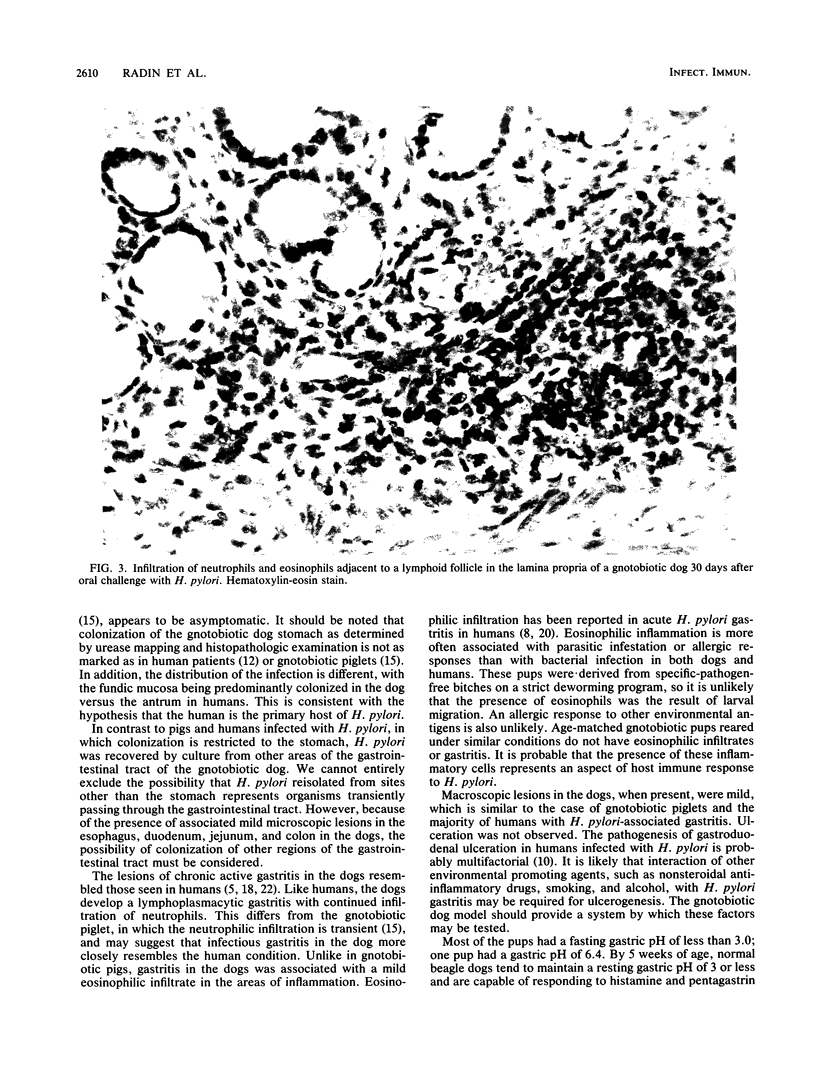
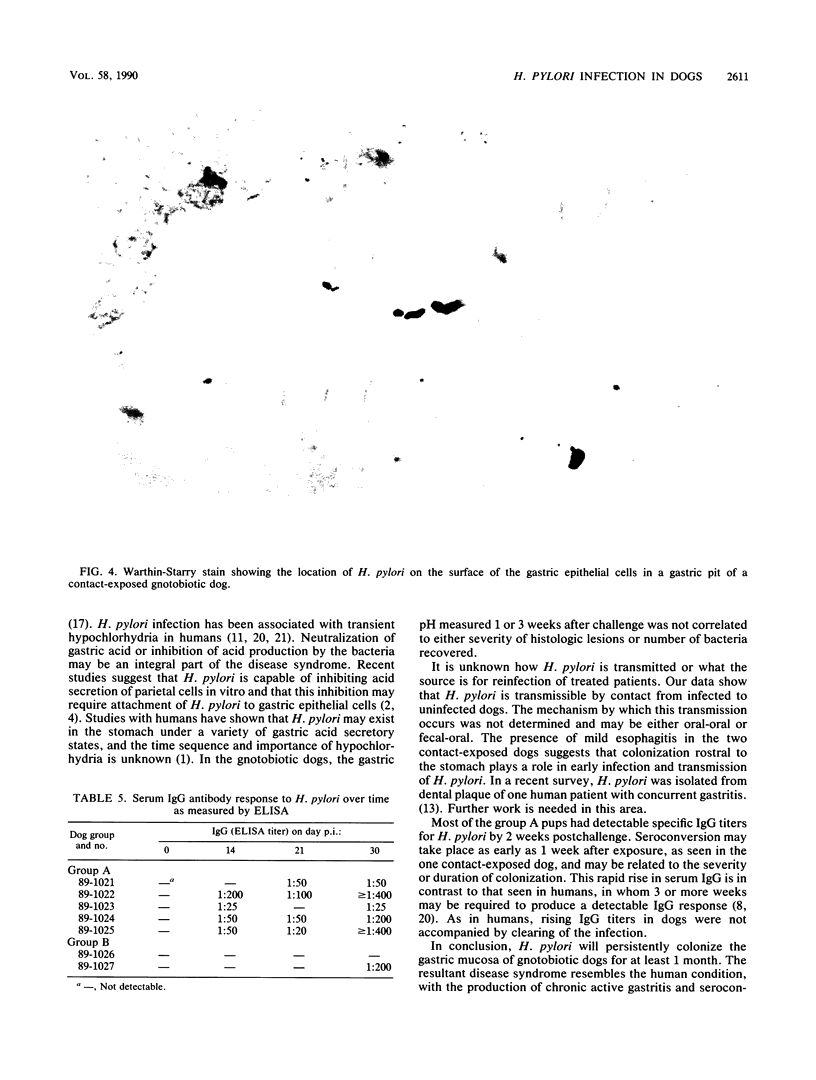
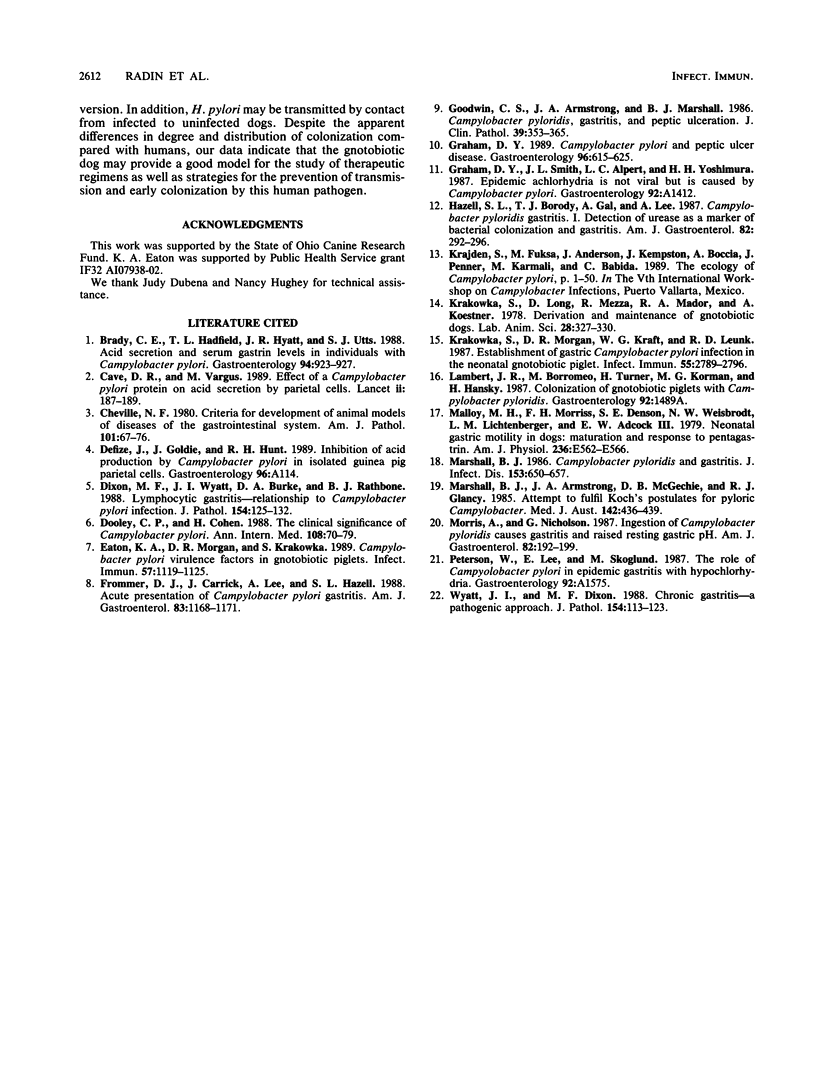
Images in this article
Selected References
These references are in PubMed. This may not be the complete list of references from this article.
- Brady C. E., 3rd, Hadfield T. L., Hyatt J. R., Utts S. J. Acid secretion and serum gastrin levels in individuals with Campylobacter pylori. Gastroenterology. 1988 Apr;94(4):923–927. doi: 10.1016/0016-5085(88)90548-3. [DOI] [PubMed] [Google Scholar]
- Cave D. R., Vargas M. Effect of a Campylobacter pylori protein on acid secretion by parietal cells. Lancet. 1989 Jul 22;2(8656):187–189. doi: 10.1016/s0140-6736(89)90372-3. [DOI] [PubMed] [Google Scholar]
- Dixon M. F., Wyatt J. I., Burke D. A., Rathbone B. J. Lymphocytic gastritis--relationship to Campylobacter pylori infection. J Pathol. 1988 Feb;154(2):125–132. doi: 10.1002/path.1711540204. [DOI] [PubMed] [Google Scholar]
- Dooley C. P., Cohen H. The clinical significance of Campylobacter pylori. Ann Intern Med. 1988 Jan;108(1):70–79. doi: 10.7326/0003-4819-108-1-70. [DOI] [PubMed] [Google Scholar]
- Eaton K. A., Morgan D. R., Krakowka S. Campylobacter pylori virulence factors in gnotobiotic piglets. Infect Immun. 1989 Apr;57(4):1119–1125. doi: 10.1128/iai.57.4.1119-1125.1989. [DOI] [PMC free article] [PubMed] [Google Scholar]
- Frommer D. J., Carrick J., Lee A., Hazell S. L. Acute presentation of Campylobacter pylori gastritis. Am J Gastroenterol. 1988 Oct;83(10):1168–1171. [PubMed] [Google Scholar]
- Goodwin C. S., Armstrong J. A., Marshall B. J. Campylobacter pyloridis, gastritis, and peptic ulceration. J Clin Pathol. 1986 Apr;39(4):353–365. doi: 10.1136/jcp.39.4.353. [DOI] [PMC free article] [PubMed] [Google Scholar]
- Graham D. Y. Campylobacter pylori and peptic ulcer disease. Gastroenterology. 1989 Feb;96(2 Pt 2 Suppl):615–625. doi: 10.1016/s0016-5085(89)80057-5. [DOI] [PubMed] [Google Scholar]
- Hazell S. L., Borody T. J., Gal A., Lee A. Campylobacter pyloridis gastritis I: Detection of urease as a marker of bacterial colonization and gastritis. Am J Gastroenterol. 1987 Apr;82(4):292–296. [PubMed] [Google Scholar]
- Krakowka S., Long D., Mezza R., Mador R. A., Koestner A. Derivation and maintenance of gnotobiotic dogs. Lab Anim Sci. 1978 Jun;28(3):327–330. [PubMed] [Google Scholar]
- Krakowka S., Morgan D. R., Kraft W. G., Leunk R. D. Establishment of gastric Campylobacter pylori infection in the neonatal gnotobiotic piglet. Infect Immun. 1987 Nov;55(11):2789–2796. doi: 10.1128/iai.55.11.2789-2796.1987. [DOI] [PMC free article] [PubMed] [Google Scholar]
- Malloy M. H., Morriss F. H., Denson S. E., Weisbrodt N. W., Lichtenberger L. M., Adcock E. W., 3rd Neonatal gastric motility in dogs: maturation and response to pentagastrin. Am J Physiol. 1979 May;236(5):E562–E566. doi: 10.1152/ajpendo.1979.236.5.E562. [DOI] [PubMed] [Google Scholar]
- Marshall B. J., Armstrong J. A., McGechie D. B., Glancy R. J. Attempt to fulfil Koch's postulates for pyloric Campylobacter. Med J Aust. 1985 Apr 15;142(8):436–439. doi: 10.5694/j.1326-5377.1985.tb113443.x. [DOI] [PubMed] [Google Scholar]
- Marshall B. J. Campylobacter pyloridis and gastritis. J Infect Dis. 1986 Apr;153(4):650–657. doi: 10.1093/infdis/153.4.650. [DOI] [PubMed] [Google Scholar]
- Morris A., Nicholson G. Ingestion of Campylobacter pyloridis causes gastritis and raised fasting gastric pH. Am J Gastroenterol. 1987 Mar;82(3):192–199. [PubMed] [Google Scholar]
- Wyatt J. I., Dixon M. F. Chronic gastritis--a pathogenetic approach. J Pathol. 1988 Feb;154(2):113–124. doi: 10.1002/path.1711540203. [DOI] [PubMed] [Google Scholar]






